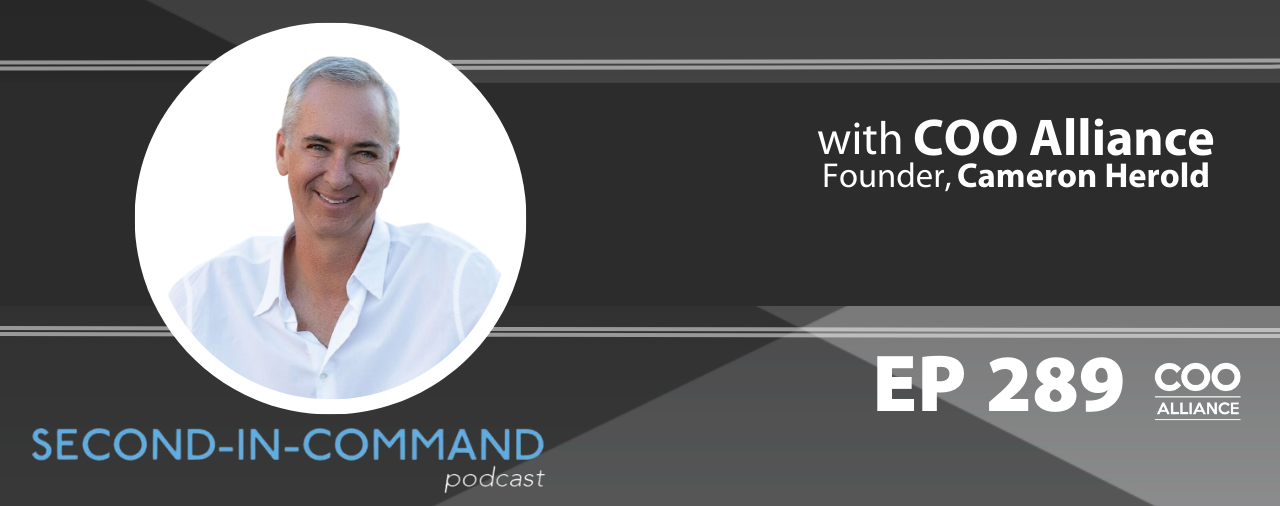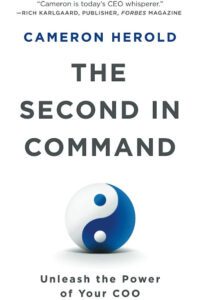This is a recast of a podcast conversation between Cameron and Bobby Richards, in which they discuss an issue that many people in business may not be aware of: what the role of a Chief Operations Officer really entails. During the discussion, they discuss the unique role of the COO, as the person who handles the tasks and elements the CEO may struggle with, or not be interested in. Cameron outlines the 30-100 employees mark, the point where a COO is generally needed to maintain day-to-day operations effectively. He also offers some thoughts on the COO hiring process, from CEO self-examination to ensuring that a candidate’s behavioral traits and values align with the company’s.
Share This Episode On:
In This Episode You’ll Learn:
- When to hire a second in command.
- The one mistake to avoid when hiring a COO.
- The importance of self-examination before hiring a COO.
- Why the COO needs to be the spotlight, rather than being in the spotlight.
- And much more!
Resources:
Connect with Cameron: Website | LinkedIn
Get Cameron’s latest book “Second in Command: Unleash the Power of your COO”
Subscribe to our YouTube channel – Second in Command Podcast on YouTube
Get Cameron’s online course: Invest In Your Leaders
—
In this episode, we have a recast of a discussion between myself and the insightful Bobby Richards. We dive into an often-overlooked aspect of the business world and the multifaceted role of a Chief Operations Officer, COO. Join us as we unravel the mysteries surrounding this crucial position that many people may not fully grasp.
Our conversation explores the unique responsibilities shouldered by a COO acting as the driving force behind tasks and elements that CEOs may find challenging or less interested in. Together, Bobby and I shed light on the pivotal moment in a company’s growth journey, specifically when it reaches the 30 to 100-employee range. It is at this juncture that the presence of a COO becomes indispensable for maintaining efficient day-to-day operations.
You’ll gain valuable insights as I share my expertise, highlighting the critical considerations involved in the COO hiring process. From introspective CEO evaluations to aligning a candidate’s behavioral traits and values with the company’s vision, we leave no stone unturned. Prepare to expand your understanding of the business landscape as we explore the pivotal role played by chief operations officers. Get ready to be inspired.
—
Cameron, thanks so much for being on the podcast today. We’re excited to have you.
JJ, thanks for having me. Appreciate it.
When this show comes out, your book will be released. It’s called The Second in Command: Unleash the Power of Your COO. I wanted to start out with this. There are a lot of people who don’t fully know what a COO does or who a COO is. Explain to me, even sharing with me, what is a COO in a company.
That’s actually why I called the book The Second in Command because the COO is one title, but there are many different titles that a second in command could have. It’s the person who would be running the business for the entrepreneur or the CEO if they were sick for six months. Who would be the de facto second in command that you would turn to to run the business for you? Who is your yin and yang? This is why I even put the yin and yang on the cover of the book. Who is the balance to the CEO? Who’s your other half?
It could be a director of operations. It could be a VP of operations. It could be a general manager. It could be a president. It could be a COO. It could even be someone like a CFO or a chief marketing officer who’s the second in command. It’s who’s that one person that the CEO would turn to for the most implicit trust, for the most operational sides of the business it would be running for them, and is their better half.
Do they end up taking a lot of the day-to-day over from the entrepreneur and the person who founded the business and started the business?
They take over the stuff that the entrepreneur sucks at and they take over the stuff that the entrepreneur doesn’t like to do. In some cases, they take the operational, but in some cases, the CEO might like operations. In some cases, they take over all the marketing. In some cases, the CEO likes marketing. It’s a very unique role. As an example, we’ve got a couple hundred members in our COO Alliance from about seventeen different countries. In some cases, the COOs run finance, some don’t. Some run IT, and some don’t. It depends on the balance of what the CEO loves to do and what they’re good at as well.
I love that. There are so many of our readers who are business owners and entrepreneurs. They’re in the process of scaling their business. Many of them started out just as a one-person operation and they’ve been able to grow their business to 5, 10, 15 employees, and even more. They’re getting to the point where they need to bring somebody in that can help them scale.
That’s exactly why you wrote this book. It’s for those entrepreneurs and for those business owners to say, “When do you need to bring in a second in command? Who are you looking for? How do you bring in a second in command? How do you work with them?” You didn’t just come to this out of thin air. You actually helped scale multiple businesses, including 1-800-GOT-JUNK? You were the COO of 1-800-GOT-JUNK? and were there when it grew from $3 million to $106 million. That’s just one of the businesses that you help scale. The wisdom that you bring to this book comes from just a very practical place.
You mentioned the 10, 12, and 15 employees. Usually, when you’re hiring a second in command, it’s about the 30-employee mark. I’ve noticed that everything changes at the 1s and the 3s, 1 employee to 3, 3 employees to 10, 10 to 30, 30 to 100. When you get to ten employees, you usually have one manager who’s managing a bunch of people for you. You have one direct report. When you have 30 employees, you probably have your first management team, 4 or 5 people managing a bunch of people, and you’re managing the management team.
When you get to 100 employees, you’ve got a leadership team of solid, seasoned execs. It’s in that 30 to 100 stage that you tend to hire the real second in command because you don’t have enough time to grow your people. You don’t have enough time to recruit other great people. You don’t have enough time to do any deep dives into business areas to see what’s happening or test your hypotheses. You don’t have enough time to work in your areas of unique ability. That’s when you need the real COO. Prior to that, you need an executive assistant.
If you don’t have an executive assistant, you are one. You need to hire the EA in the early stage and probably a couple of people that are great at project management and time management, and can do a lot of stuff but aren’t necessarily domain experts. That first true second in command, that true COO or VP of operations tends to happen in the 30 to 100.
Let’s dive into some questions that I have. These are personal questions I have. You’re going to start coaching me here a little bit. Let’s say I’m a business owner and I have about 30 employees. What is one mistake that I would make in looking for a COO or a right-hand person? What’s a mistake I should avoid?
Right away wanting to go hire somebody who was a COO somewhere else and say, “Can you be mine?” amazes me. I’ve had so many people come to me and say, “Would you be my COO?” I’m like, “You don’t know anything about my actual skills. You don’t know my behavioral traits. I have no idea what your company’s core values are or who you are. I have no idea if we’re going to be a fit.” That’s like going on one blind date and saying, “Will you marry me?” You just don’t know enough information about the person to say that.
The second thing is the CEO or the entrepreneur not thinking enough about themselves, about what they’re good at, what they suck at, what feeds them with energy and what drains them of energy, of what buckets they want somebody else to run for them, and then finding somebody who’s good at those areas and doesn’t want to manage the areas the CEO wants to. It’s almost that self-examination that you have to start with before just going out and hiring, “You were a COO. Great, be mine.”
That’s so huge. I know that I’ve watched multiple companies make that same exact mistake. It’s like, “I need somebody who is a factory floor manager essentially, somebody who comes in and works at the details and does the day-to-day,” and yet the business owner wants to be involved in the day-to-day. What they don’t want to be involved with is some of the marketing and some of that other side of things. They hire somebody who’s doing the day-to-day. The reality is the entrepreneur wants to do the day-to-day, and they end up conflicting with each other and the person that’s gone within three months.
You need to know the kind of company they were in. You also need to know the stage of growth they were at. I was a fantastic COO for 1-800-GOT-JUNK? from $2 million to $106 million. Their COO, Eric, has been there for several years now and has been a fantastic COO.
They went down to $70 million when they replaced me with a former president of Starbucks. The company dropped from $106 million down to $70 million. Eric came in at about $70 million and has grown it to $450 million. Eric was a fantastic COO from $70 million to $450 million. He would’ve been horrible in the first six years when I was there because he didn’t have the skills to do what needed to be done in that era, just like I would’ve been horrible at his.
Even though we were both COOs for the same company, there was a time period that we were good for. I needed to understand franchising, how to start a franchise company from scratch, how to do the marketing budgets, marketing collateral, and marketing calendars, hire the PR team, hire the coaching team, set up a leadership program, set up a franchise program, set up a franchise training program. Now all those things are set up, Eric needs to know how to leverage them and deal with the politics and people, stuff I’m not good at. It’s a very unique process that you have to go through in finding that perfect fit.
I’m loving this because this frees up people a lot. When they’re looking for this next spot, is first starting with that self-examination and going, “What are the parts I want to keep doing and I’m good at and, in many ways, the company needs me to do as a CEO and entrepreneur? If I’m good at this and I want to keep doing it, I need to have some self-examination and identify what are the things I’m good at, what the company needs me to do, and who I need to bring in second in command that can do the other things.”It is that self-examination, and then identifying somebody who has gifts in those areas and also who has experience in the same stage of business growth that I am in that can help me go from $10 million to $100 million or $5 million to $20 million.
You know what also happens around that 30 to the 100 stage as well is, often when you think you need the COO, what you might need is a chief marketing officer. Maybe most of the stuff you need to get off your place is marketing. That’s a CMO. Maybe most of the stuff that has to come off your plate is operational. It could just be a VP of ops, but you don’t want them running the rest of the business. Sometimes, the first few key hires are domain experts. All of a sudden, you end up with a leadership team of people. That tends to be when you need the real COO as someone to come in and manage the rest of the leaders.

Chief Operations Officer: Sometimes the first few key hires are domain experts, and then all of a sudden you end up with a leadership team of people. That tends to be when you need the real COO as someone to come in and manage the rest of the leaders.
You found a right-hand person and you brought them in. What are some things that you would say to CEOs that they can do to empower that second in command to be able to do the job you need them to do?
One is to build a strong relationship with them so that you have a high degree of trust and a high degree of communication so that you can stay on the same page and you can have a good debate. The second is to shine a light on them. The CEO has to make the COO look good inside the company just as the COO has to shine the spotlight on the CEO to make them iconic inside the company.
Another thing the CEO has to do is stay out of the COO’s way, to not meddle in those areas that you used to run. Just because you used to run that area or because you started the company doesn’t mean you get to jump over him or her and dive into those areas without running it as a proper skip-level meeting. I talk about some systems to be able to do some of the domain deep dives, but not do the wrong thing or say the wrong thing because you’re in somebody else’s area.
Sometimes, when I’ve been second in command, I see myself as the spotlight instead of being in the spotlight. You’re the person who shines the light on other people in the organization. In the roles that I’ve played anyway as second in command, I’m shining the light on other people in the organization. My job is also to shine a light on the CEO and the president to elevate them. If you find yourself in a position where you’re competing with your COO or you’re second in command, that’s probably a red flag.
It’s a red flag because there’s either some insecurity that you have or there’s something you’re not being fulfilled with. That’s time to step aside with the COO, get back on the same page, build a relationship, and build trust. The leader’s core job is to grow people, not to hold them accountable, not to manage them, not to herd cats. The leader has to show up every day focused on growing the skillset and the confidence of their people. If they do that, the company scales.
So often, leaders are so myopic and so focused on the business area they’re running or the stuff that they’re good at, they forget that their core job is to grow people. What I like to do is flip the org chart upside down where the CEO and the COO are at the bottom of the org chart supporting the VPs and supporting the managers and supporting the employees who are supporting the customers. It’s an upside-down pyramid. If you think about it and visualize it that way, you realize investing in your leaders and their growth and giving them the skills, it’s almost irresponsible not to do it.
You created a course to help people do this called Invest in Your Leaders. You are giving our readers a nice little bonus, a little gift. If readers go to InvestInYourLeaders.com and use the promo code BMS 10, you’re going to get a 10% off of Cameron’s Invest in Your Leaders course. You can go to InvestInYourLeaders.com, use the promo code BMS 10, and you can even get more wisdom from Cameron on how to invest in your leaders in your company and grow your people.
Cameron, thank you so much for being with us. Your book brings together so much wisdom and so much great and practical advice. For anybody out there who is at that spot where your company is growing and you’re looking to bring in a second in command or you’re looking at taking it to the next level and bringing in somebody else, go and get his book. You will not regret it. It is called The Second in Command: Unleash the Power of Your COO. Cameron, thank you so much. This has been, in some ways, even a healing conversation for me. I appreciate it. I know that all of our readers are going to get a ton out of it. Thank you so much.
Thanks, JJ. I appreciate it.






